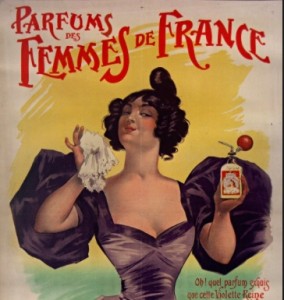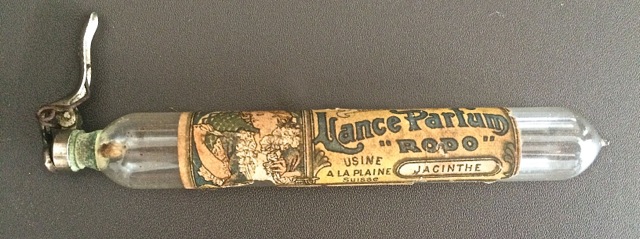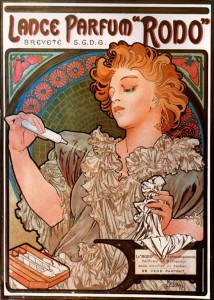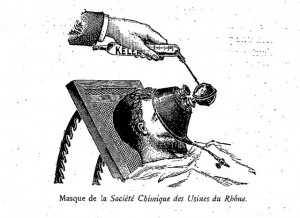 By Cheryl Krueger (Guest Contributor)
By Cheryl Krueger (Guest Contributor)
Multi-million dollar advertising campaigns attest to a thriving perfume industry in North America and the European Union. An average of three new perfumes per day were released in 2011 alone. But not everyone is high on perfume. The International Fragrance Association (IFRA) adheres to a self-regulatory Code of Practice (perfume enthusiasts liken it to Hollywood’s Hays Code, and regularly introduces restrictions to protect consumers and the environment from potential perfume-induced dangers. France’s fragrance industry battles constant proposals from the European Commission to restrict or ban materials like natural oak moss and coumarin, longtime cornerstones of classic French perfumery. In North America especially, there is a growing movement toward fragrance-free zones, and legislation protecting office workers from the imposing, even toxic sillage of their colleagues.
This love-hate relationship with perfume is not a new phenomenon. As the modern French perfume industry boomed in the nineteenth-century, perfumers found themselves defending the safety of natural and synthetic materials in fragrant cosmetics. These included face powders, lotions, bath milks, pastes, pomades, and liquid perfumes. Concerns about the danger and abuse of perfume were expressed not by regulatory committees, but in manuals of beauty, etiquette and hygiene, the popular press, and medical treatises dealing with nervous disorders and hysteria.
Though warnings of perfume’s moral and biological toxicity were often overstated, there was one product that may have lived up to the hype: the Lance-parfum Rodo.
 Other print ads for perfume in the late nineteenth and early twentieth centuries emphasized handkerchiefs, one of the many accessories that served as vehicles for personal perfuming.
Other print ads for perfume in the late nineteenth and early twentieth centuries emphasized handkerchiefs, one of the many accessories that served as vehicles for personal perfuming.
In fact, perfumers’ manuals show that liquid perfume (parfum liquide) was synonymous with handkerchief perfume (parfum pour le mouchoir).
So what was unique about the lance-parfum Rodo?
It happens that the device was as much a pharmaceutical product as a fragrant accessory.
Patented in 1897 by chemical manufacturer la Société Chimique des Usines du Rhône, the lance-parfum Rodo was the serendipitous reincarnation of an ethyl chloride dispenser called the Kélène lance chlorure d’ethyle, which preserved ethyl chloride in portable, single-use glass or metal tubes for use as local and general anesthesia.
The Société Chimique des Usines du Rhône manufactured both pharmaceuticals and synthetic perfume ingredients. One day violet fragrance spilled into ethyl chloride, and an idea was born. Like its medical prototype, the lance-parfum was a portable projection system for (now perfumed) ethyl chloride, released automatically when the seal was broken. When liquid ethyl chloride meets warm air, it vaporizes. This is good news for linens and white handkerchiefs.
The Lance-parfum Rodo was manufactured in a variety of scents, including heliotrope, hyacinth, lily-of-the-valley, and Peau d’Espagne. Still, the gadget is absent from popular manuals by perfumers such as Septimus Piesse, whose works were reissued in French and English throughout the nineteenth century. A column in the August 1911 issue of the trade manual La Parfumerie moderne summarizes the chemistry and mechanics of generic “lances-parfums,” emphasizing the refreshing sensation produced by solvents including ethyl chloride, but also deeming the gadgets dangerous because they are highly flammable (“Recettes et Procédés Utiles”107-108).

A Rodo perfume launcher from the author’s collection.
The lance-parfum was heavily marketed at the Rio Carnival, where users reportedly suffered intoxication, hallucinations, and cardiac trouble. Due to deaths related to lance-parfum abuse, the product was finally outlawed in the 1960s.
Was lance-parfum swooning similarly rampant in fin-de-siecle France? If so, not for long. Though other French companies applied for patents, the threat of the Great War brought most marketing plans to an early halt. (1) It is possible, though, that the presence of ethyl chloride-based perfumes helped to fuel less convincingly substantiated reports of eccentric fin-de-siècle perfuming, such as subcutaneous perfume injection, perfume drinking, and the unusual case of a scent-huffer getting high on Guerlain’s groundbreaking 1889 Jicky perfume. (2)
[1] For a detailed review of the development and patent history of the lance-parfum, see Raynal, Cécile and Thierry Lefebvre, “Le Lance-parfum. Un matériel médical devenu accessoire de carnaval.” Revue d’histoire de la pharmacie 56.357 (2008): 63-79.
[2] Reported in Antoine Combe’s Influence des parfums et des odeurs sur les névropathes et les hystériques (Paris: A. Michalon): 1905.
Cheryl Krueger is Associate Professor of French at the University of Virginia. You can read more about alleged fin-de-siècle perfume abuse in her article Decadent Perfume: Under the Skin and Through the Page.
Any questions about Bric-a-brac-o-mania, W&M’s new column about nineteenth-century cultural artifacts and more? Contact Rachel Mesch, rachel.mesch@gmail.com.


